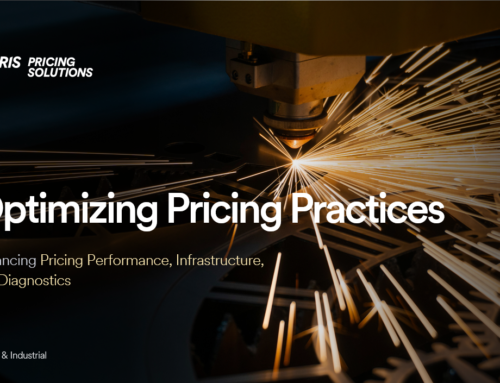By: Benjamin Garden, Director, Pricing Analytics, Iris Pricing Solutions
It’s no secret that pricing has a direct impact on profitability and customer satisfaction. In the digital age, where customers have access to information about prices from around the world in seconds, implementing effective pricing strategies is becoming increasingly important for businesses. With this in mind, using analytics-driven insights into how your customers are reacting to different price points can be incredibly beneficial – helping businesses to retain current customers while improving profits over time. Here, we’ll explain 5 smart ways that leveraging pricing analytics will help you grow your business even further:
1) Gather Data on Your Customer Base
Before you can use pricing analytics effectively, you need to understand who your customers are and what they buy. Gather data about your current customers, including their purchase histories and preferences. Transaction data can be used to model price elasticities, cross-elasticities, and ultimately optimize pricing strategies. Price elasticity is a measure of how sensitive customer demand is to changes in product prices. Cross elasticity measures the demand for one product in response to changes in the price of another product. Understanding the relationship between customer spending and products will allow you to target promotions and discounts more accurately for greater efficiency. Additionally, consider gathering data about potential new customers and what products brought them to the brand. This will help you better understand your market as a whole and identify opportunities for growth.
Demographics play an important role in pricing analytics, as understanding the demographic data of customers can help businesses make more informed decisions about their pricing strategies. Demographic data includes information such as gender, age, location, income level, and more. This data can be used to target specific customer segments and identify profitable opportunities.
Don’t have access to transaction data or demographics? Well, if you’re a network of physical retail stores, there is now aggregated, privacy-compliant mobile device tracking data available to provide important insights into customer demographics. This can generate a customer profile of foot traffic to your retail location, competitor locations, and customer journeys through their day. This enables businesses to better target their marketing initiatives and optimize pricing strategies.
2) Analyze Your Competitors
It’s also important to pay attention to what your competitors are doing with their pricing strategies. Monitor their pricing models, discounts, promotions, etc., so that you can anticipate their next move and be prepared with an effective response. The best way to do this is to track competitor prices over time using automated competitive intelligence tools. This will help ensure that you remain competitive in the market without sacrificing too much of your profit margin in the process.
To effectively use competitive intelligence data for pricing analytics, brands must first identify which websites are most relevant for their particular industry and business goals. For example, if a brand sells electronics, it would be beneficial to scrape sites such as Amazon or Best Buy which have large catalogs of electronic products. Additionally, it is important to find websites that have up-to-date information on pricing trends so that businesses can make more informed decisions about their own pricing strategies.
Once the relevant websites have been identified, businesses can use automated tools to extract the data from those sites. This data can then be built into a live dashboard designed as an early detection of price or promotion changes. With this knowledge in hand, brands can also anticipate any changes that competitors may make in the future. This can be used to spot opportunities for discounts or promotions that will attract new customers while keeping existing ones engaged with special offers – resulting in increased profits overall.
By leveraging web-scraped data for pricing analytics, brands are also able to fill in gaps in their product offerings very quickly – allowing them to avoid inventory shortages or periods of low demand due to a lack of variety. These are tools to ensure long-term success through smarter decisions made faster than ever before.
3) Develop Segmented Pricing Strategies
One of the most effective ways of using pricing analytics is segmenting different customer profiles into different price brackets or tiers based on their buying behavior or preferences. For example, if a certain segment of customers tends to buy more frequently than another segment, then it makes sense to offer them higher discounts or bonus points when they make purchases in order to encourage loyalty from them. Similarly, if certain segments of customers tend not to buy too much, then it might be wise to lower prices for those customers in order to entice them into making more purchases. By segmenting prices according to customer behavior or preferences, you can ensure that each customer feels valued while maximizing profits at the same time.
In addition to tailoring prices based on buying patterns, it’s also important to conduct customer research in order to gain a better understanding of the underlying value drivers behind why customers choose to buy from your brand over others. This type of research can help companies better identify key product features or services that are most sought after, which in turn allows them to fine-tune their pricing strategies.
Companies can employ different strategies – such as focus groups, surveys, and interviews – in order to gain deeper insights into their customer segments and uncover what it is they truly value when making purchase decisions. Understanding the needs and motivations behind each segment can then allow companies to tailor their product or services accordingly and adjust prices accordingly.
By using customer research strategies like these, companies can ensure that their offerings appeal more broadly across different types of customers while still delivering the maximum value for each price point. This helps create an optimal balance between customer satisfaction, loyalty, and revenue generation.
4) Test Different Price Points
Testing different price points is another great way of optimizing profits through pricing analytics. Try offering products or services at different price points (e.g., premium versus basic) and see which one brings in more revenue over time. This is an especially useful strategy when launching a new product or service – by testing different price points before settling on a final one, you can ensure that the chosen price point will generate maximum profits for the company while remaining attractive enough for customers as well.
Testing different price points is an important part of optimizing profits through pricing analytics. Companies can utilize a variety of methodologies to assess the right price point, such as the Van Westendorp approach, Fair Price “Think Twice” and conjoint analysis.
- The Van Westendorp approach, surveys customers to ask at what price point they would perceive an item to be either too expensive, a bargain, too cheap, or about right. This helps identify an optimal range for the item’s price that will draw in customers without sacrificing profits.
- The Fair Price “Think Twice” methodology, relies on data from customers who are asked to determine whether or not they would purchase a product based on different price points; it then uses this data to determine the highest possible fair price for a product.
- Conjoint analysis, surveys customers on their preferences for different features of a product and how much they’re willing to pay for them; this method allows companies to understand how customers make purchasing decisions and optimize prices accordingly. By employing these methods and testing out different price points, companies can ensure they are offering prices that appeal to their target audiences while still delivering maximum profit.
Combining customer research results with analytics using customer order behavior transaction data is a powerful and effective way for companies to gain deeper insights into their customers and optimize their pricing strategies. By leveraging the power of big data, companies can analyze customer behavior patterns in great detail and uncover valuable insights into customer preferences, values, and motivations that would otherwise be difficult
5) Price Optimization
Price optimization is essential for businesses looking to maximize profits and remain competitive in their industry. Through simulations using product level elasticity, cross elasticity, and the market basket effect, companies are able to identify the optimal prices across their entire portfolio.
Product level elasticity determines how much the demand or revenue will change when a single price is adjusted; while cross elasticity looks at how two different prices can change the overall revenue of the company; and finally, market basket effect assesses pricing scenarios that include multiple products sold together. By analyzing these three factors in tandem, companies can simulate different price points to determine which yields the highest revenue or margin.
By leveraging loyalty data, companies can gain an even clearer picture of customer order behaviors. This allows for an additional layer of insights to be added when fine-tuning the pricing optimization process, allowing businesses to optimize prices according to their customers’ purchasing habits. Furthermore, collecting and analyzing loyalty data can help identify opportunities to boost customer loyalty by understanding how customers respond to certain discounts or promotions, thus ensuring that they remain loyal in the long run.
Once an optimal price model has been established through simulation, businesses should regularly adjust prices in order to train customers about pricing dynamics – otherwise customers may become accustomed to static discounts or prices which can adversely affect profits in the long run. Discounts and promotions can often be addictive for the business, while customers simply “wait for a sale” before making a purchase because it’s become the trend they come to recognize.
By leveraging simulated models to optimize pricing strategies and adjusting prices often, businesses can benefit from increased revenue and margin while meeting customer expectations. Ultimately, this leads to improved bottom lines and better positioning within their respective industries.
Conclusion
By implementing proper pricing analytics, businesses can ensure that customers remain loyal while maximizing profits. Through simulations of product level elasticity, cross elasticity, and the market basket effect, companies gain insights into how prices can be adjusted to create optimal price points. Furthermore, leveraging loyalty data helps identify opportunities to further customize pricing strategies and boost customer loyalty in order to retain customers over time. By taking advantage of these strategies, businesses can gain a competitive edge in their respective industries and achieve greater success.
Our analytics approach at Iris Pricing Solutions is ahead of the pack because it is designed to effectively connect all types of data in order to provide more robust, realistic, and accurate insights. It’s also tailored to each client, and that personalized approach is critical for increasing revenue and achieving positive bottom-line growth. Contact us to learn more about how we can help you transform your business.





